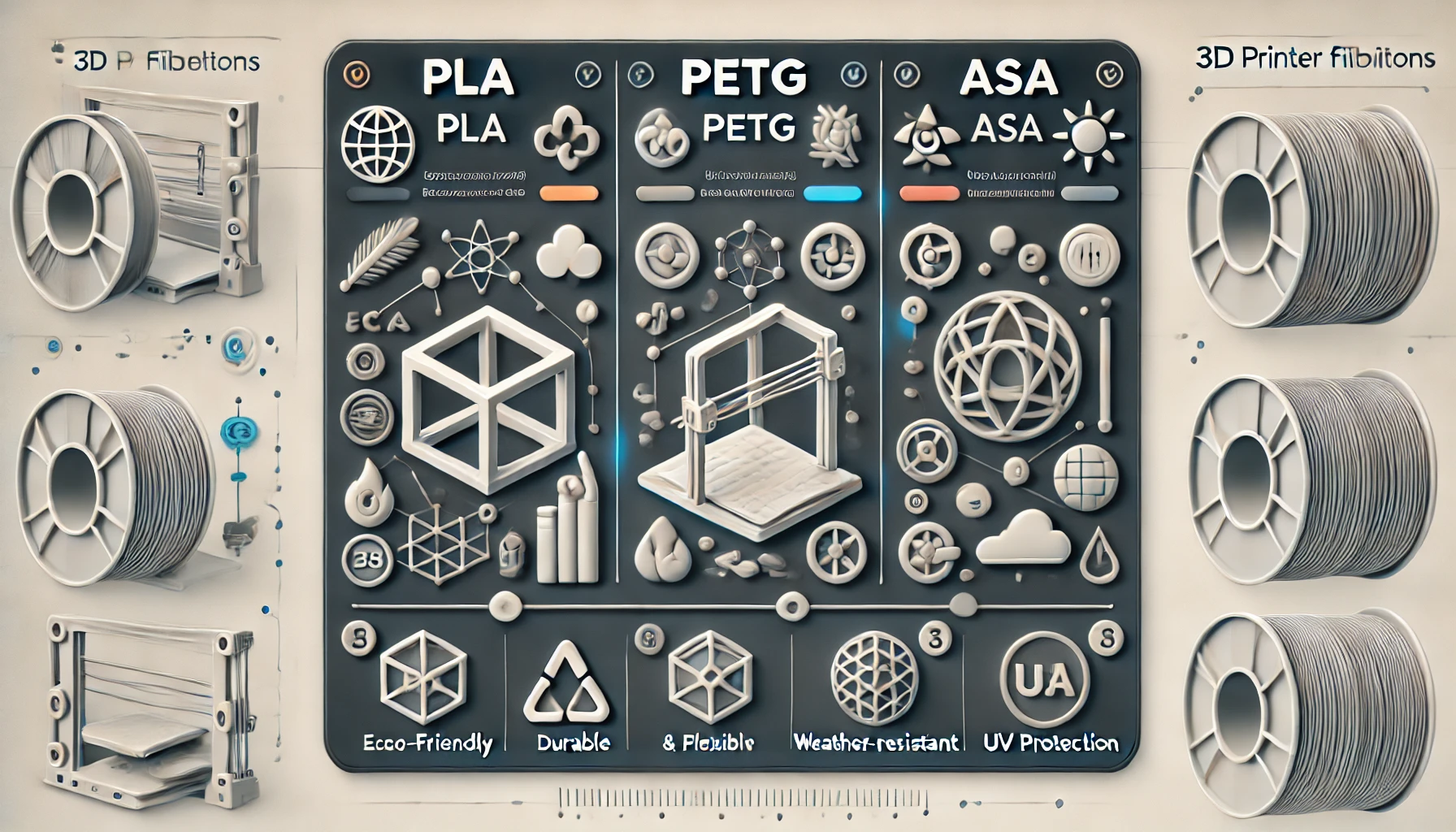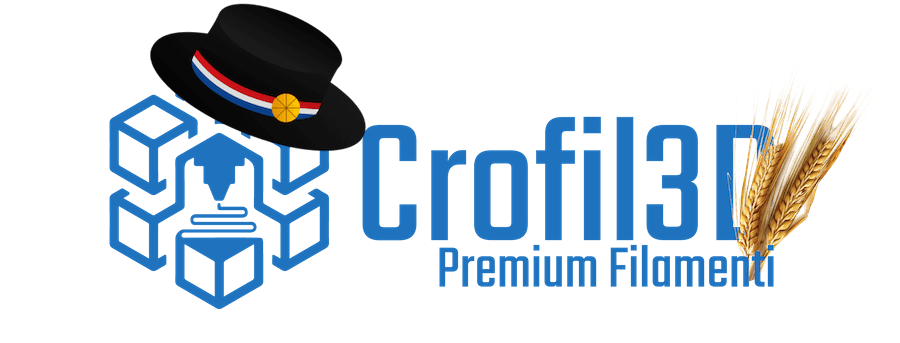
Introduction
As the world of 3D printing continues to evolve, designers are faced with an expanding array of materials to choose from. Each filament type has unique properties and applications, which can significantly impact the quality and functionality of the final product. In this article, we will explore three popular 3D printing filaments—PLA, PETG, and ASA—focusing on their properties, printability, and suitability for various applications. By the end of this article, you’ll have a clearer understanding of which filament may be the best fit for your next project.
Material Properties
PLA: Biodegradable and Easy to Use
Moreover, the low odor emitted during printing with PLA is another reason why many designers favor this filament, enhancing the overall experience while working with it.
PLA is one of the most commonly used 3D printing materials. Made from renewable resources like corn starch or sugarcane, it is biodegradable, making it an environmentally friendly option. This filament, PLA, is known for its low melting point, which allows for fast printing and excellent layer adhesion. Its rigidity and aesthetic finish make it an ideal choice for prototypes and decorative items. However, PLA has a relatively low heat resistance, which can limit its use in functional applications.
One of the standout features of this material is its availability in a variety of colors and finishes, including matte and glossy options. This versatility allows designers to create visually striking prints without the need for post-processing. Additionally, it emits a sweet odor when heated, which some users find pleasant compared to other filaments. Overall, this option is an excellent choice for those looking for ease of use and visual appeal.
Additionally, PLA is frequently chosen for its user-friendly qualities, making it a top pick for entry-level 3D printing projects. Many designers appreciate how easy it is to work with PLA, as it simplifies the printing process.
PETG: Strength and Flexibility
PETG, or Polyethylene Terephthalate Glycol-modified, is gaining popularity among designers for its superior strength and flexibility compared to PLA. This filament combines the ease of printing associated with PLA and the durability of ABS (Acrylonitrile Butadiene Styrene). PETG can withstand higher temperatures than PLA, making it suitable for functional parts and prototypes that require more resilience. Its impact resistance is another key feature, providing robustness for parts that may be subject to stress or wear.
Another advantage of PETG is its excellent layer adhesion, which results in prints that are less prone to warping and delamination, traits that can plague other filaments. PETG also has good chemical resistance, making it suitable for applications involving moisture or certain solvents. Designers appreciate its ease of use, as it prints smoothly and can achieve a glossy finish without extensive post-processing.
ASA: UV Resistance and Durability
ASA, or Acrylonitrile Styrene Acrylate, is a filament specifically designed for outdoor applications. Its UV resistance makes it ideal for projects exposed to sunlight, preventing degradation and color fading over time. ASA retains the strength and durability associated with ABS while offering improved weather resistance. This makes it a preferred choice for outdoor signage, automotive parts, and any application requiring long-term exposure to the elements.
While ASA shares some characteristics with ABS, it is less prone to warping and cracking, which can be significant advantages for designers. The printing process may require a heated bed and an enclosed printing environment to minimize issues, but the results are well worth the effort. The final prints showcase a high-quality finish, making ASA a fantastic option for both functional and aesthetic projects.
Printability
Ease of Printing with This Material
This filament is often recommended for beginners due to its user-friendly nature. The low melting point allows it to be printed at lower temperatures, which reduces the risk of warping and makes it compatible with a variety of printers. Additionally, it adheres well to most build surfaces, making it less likely to lift during printing. As a result, users can achieve impressive print quality with minimal adjustments.
One crucial consideration while printing with this material is to ensure adequate cooling. Since it can be sensitive to heat, using a cooling fan during the printing process is advisable to maintain layer adhesion and prevent deformation. Overall, its ease of use makes it an excellent go-to filament for designers, especially those just starting in 3D printing.
PETG: Balancing Difficulty and Quality
PETG strikes a balance between ease of use and print quality. While it is generally easy to print, designers may encounter challenges related to stringing and oozing due to its higher viscosity. This necessitates fine-tuning printer settings, including temperature and retraction settings, to achieve optimal results. Many users find success with a slightly higher print speed and adjusted retraction settings to minimize these issues.
Moreover, having a heated bed is beneficial when working with PETG to ensure proper adhesion and reduce warping. While PETG may require a bit more attention than PLA, the outstanding strength and durability it offers make it worth the effort. Once designers become familiar with its quirks, PETG can produce stunning, high-quality prints that stand up to real-world use.
ASA: Tips for Successful Printing
Printing with ASA can be a rewarding experience, provided that the right conditions are set. Due to its sensitivity to temperature, it is best printed in a controlled environment, such as an enclosed printer or with a heated chamber. This helps prevent warping and ensures consistent layer adhesion. A heated bed is essential, typically set at around 80-100°C, to maintain print quality.
Designers should also consider using an all-metal hotend, as ASA can be abrasive and may wear down standard PTFE-lined hotends over time. Additionally, if the intended application involves exposure to UV light, choosing a high-quality ASA filament can enhance longevity and performance. With the right setup and attention to detail, ASA can deliver exceptional prints that withstand outdoor challenges.
Additionally, the versatility and adaptability of PLA make it well-suited for a variety of creative projects, allowing designers to experiment with complex designs.
Application Suitability
PLA is not only popular among hobbyists but also widely utilized in educational settings, where its ease of use allows students to grasp 3D printing concepts effectively.
Creative Projects with PLA
PLA is favored in the creative and artistic community due to its ease of use and vibrant color options. Designers often utilize PLA for creating prototypes, decorative items, and intricate designs that showcase complex geometries. Its low melting temperature makes it perfect for printing detailed models quickly and efficiently, allowing designers to iterate rapidly on their ideas.
In addition to artistic applications, PLA can also be used in educational environments. Schools and workshops frequently employ PLA to teach students about 3D printing and design principles, as it offers a forgiving learning curve. The resulting prints are often aesthetically pleasing and can be used for various projects, from art installations to functional classroom demonstrations.
Functional Parts with PETG
PETG’s unique combination of strength and flexibility makes it an excellent choice for functional parts that require durability. Designers often turn to PETG when creating items such as mechanical components, casings, and prototypes that need to endure wear and tear. Its chemical resistance also allows for applications in environments where exposure to moisture or solvents is a concern.
The ability to print strong, lightweight parts makes PETG particularly attractive for industries such as automotive and aerospace, where component performance is critical. Additionally, PETG can be used for creating custom tools and jigs, allowing designers to optimize their workflows without compromising on quality.
Outdoor Applications with ASA
Given ASA’s superior UV resistance and durability, it is the go-to filament for outdoor applications. Designers often use ASA to create components for outdoor furniture, garden decorations, and signage that must withstand the elements. The long-lasting nature of ASA ensures that pieces remain intact and visually appealing over time, even when exposed to harsh weather conditions.
In addition, ASA is suitable for functional parts in outdoor settings, such as automotive parts and protective housings. Its ability to retain structural integrity under stress makes it an ideal choice for items that need to endure both physical and environmental challenges. When choosing a filament for outdoor projects, ASA should be at the top of the list for any designer aiming for longevity and reliability.
Comparison Summary
The choice of filament can significantly influence the outcome of a 3D printing project, and understanding the strengths and weaknesses of PLA, PETG, and ASA is crucial for designers. Below is a summary of key attributes of each filament:
| Filament | Strengths | Weaknesses | Best For |
|---|---|---|---|
| PLA | Easy to print, biodegradable, aesthetic variety | Low heat resistance, brittle | Prototypes, decorative items, educational use |
| PETG | Strong and flexible, good chemical resistance | Can require fine-tuning for optimal results | Functional parts, mechanical applications, prototypes |
| ASA | UV resistant, durable, weatherproof | Requires controlled printing environment, can be abrasive | Outdoor applications, automotive parts, long-lasting designs |
Conclusion
Choosing the right filament for your 3D printing project is crucial to achieving the desired quality and functionality. PLA stands out for its ease of use and aesthetic options, making it a favorite among beginners and artists. PETG offers a strong and flexible alternative, suitable for functional applications where durability is key. Meanwhile, ASA shines in outdoor environments, providing UV resistance and longevity.
Ultimately, understanding the properties and applications of each filament type allows designers to select the best material for their specific needs. Whether you’re working on a creative project, producing functional parts, or designing for outdoor use, the right filament can make all the difference in the success of your project.
FAQs
What is the best filament for beginners? PLA is often recommended for beginners due to its ease of use and forgiving nature during printing.
Can PETG be used for outdoor projects? Yes, PETG is suitable for outdoor projects, offering good strength and moisture resistance, although ASA is typically preferred for UV resistance.
Is ASA harder to print than PLA? ASA can require more attention during printing, such as a heated bed and controlled environment, making it slightly more challenging than PLA.
Which filament is the most environmentally friendly? PLA is the most environmentally friendly option, being biodegradable and made from renewable resources.
Can I paint my 3D printed parts? Yes, all three filaments can be painted; however, proper surface preparation and primer may be necessary for the best results.



